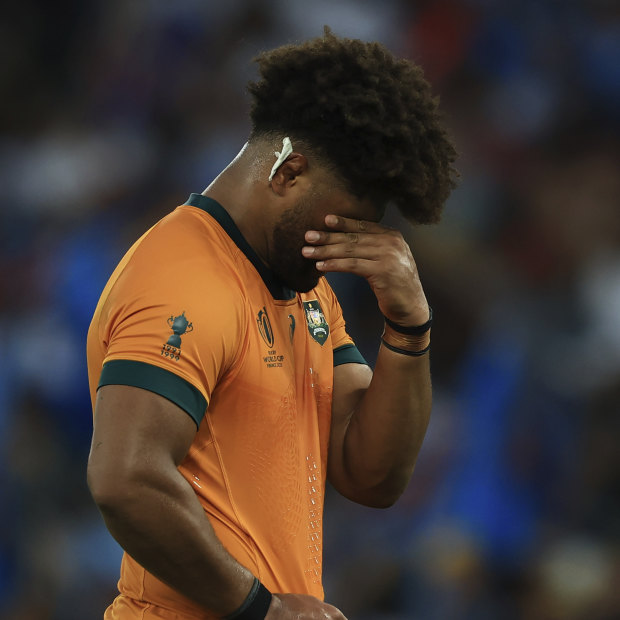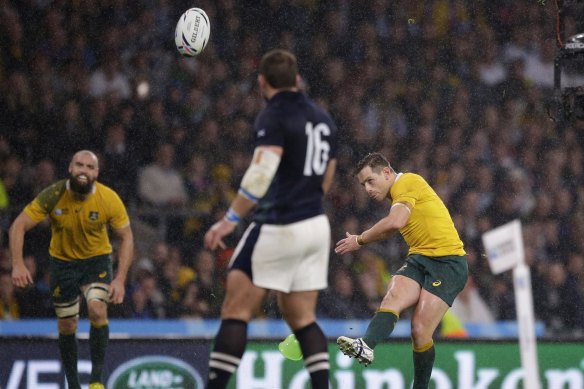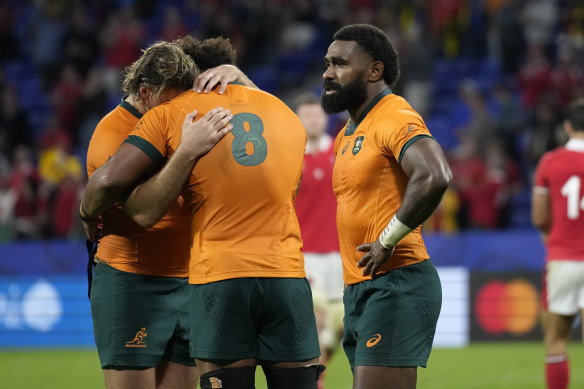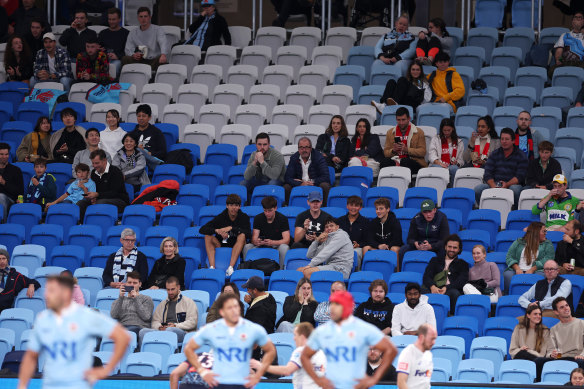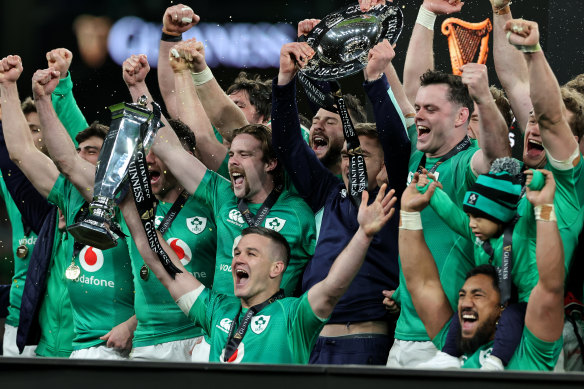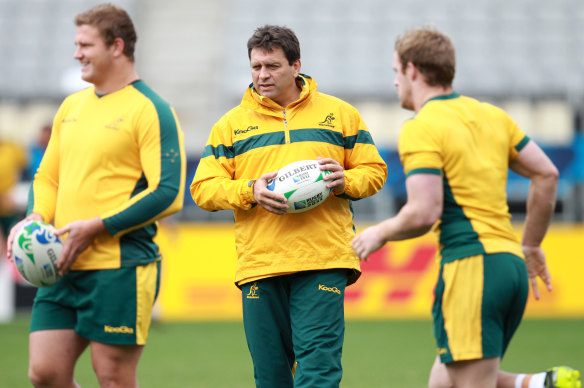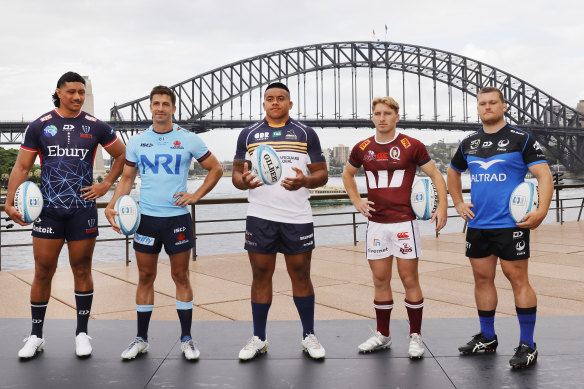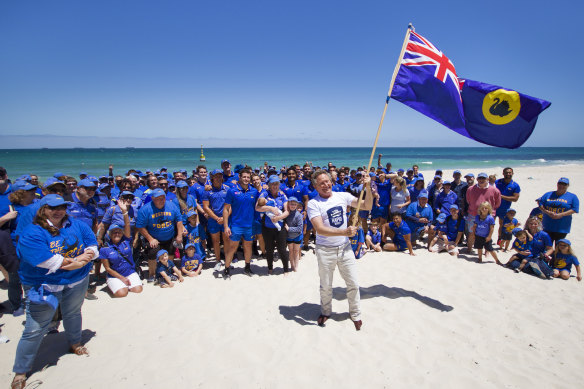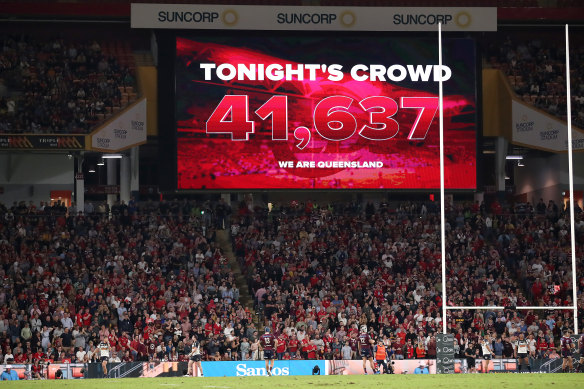By Iain Payten
Rob Valetini after the Wallabies’ loss to Fiji at the World Cup in France.Credit: AP
Save articles for later
Add articles to your saved list and come back to them any time.
The actions – or inaction – of many people over many years have conspired to put Australian rugby into the dark hole it finds itself.
But South African referee Craig Joubert might be surprised to learn his name has been added as a contributor in some Australian rugby circles this week.
Rewind to the 2015 World Cup, and the final minute of the Wallabies’ quarter-final against Scotland. The Scots were leading 34-32 and Australia were heading home. But from a messy lineout, Joubert contentiously penalised the Scots for being offside and Bernard Foley nailed a penalty for the win.
Joubert raced off the field, became a pariah in Scotland, and World Rugby later admitted he’d made the wrong call. The Wallabies went on to reach the final. Australian rugby was back, baby.
“We should have gone out in the quarters against Scotland in 2015,” one former Australian rugby official, who requested anonymity to speak freely, said.
Bernard Foley kicks the match-winning penalty against Scotland in 2015.Credit: AP
“And we’d have been doing all this eight years ago, when it was needed.”
Whatever air was in the 2015 tyres hissed out quickly in 2016, when Australian teams won just 40 per cent of Super Rugby games and the Wallabies got whitewashed 3-0 by Eddie Jones’ England. Over the next four years, Super Rugby success wallowed between 28 per cent and 45 per cent, and at one point, Australian teams went 40 games without a win against a Kiwi side.
The Wallabies’ success rate went downhill, too, and after a quarter-final exit in 2019, wins were even harder to come by for the next four years. Soon enough, the humiliation of France 2023 arrived.
“It was a chicken come home to roost game for the Wallabies,” former Wallabies centre Morgan Turinui said of the Wales loss on Stan Sport this week.
Fraser McReight, left, and Rob Valetini console each other in Lyon.Credit: AP
“This year has been an acceleration of an already steady decline. Let’s not say everything is rosy and we have fallen off a cliff. We have been going downhill for a long, long time.”
In the best traditions of “never waste a good crisis”, despondent rugby types are clutching at the hope that the Australian game’s darkest week will finally stop the can being kicked down the road, with meaningful reform now an existential necessity.
“Everyone is screaming out, and we probably said it before the World Cup, even: if not now, then when?” Melbourne Rebels chief executive Baden Stephenson said.
“We have hit ground zero and none are enjoying this. We all want to get better and we are nowhere near where we need to be. So we all have to be part of the solution.”
But what are the problems? And can solutions be agreed upon?
‘PERNICIOUS DOWNWARD SPIRAL’
Rugby’s big problem is it doesn’t have one big problem, according to Hunter Fujak, a lecturer in sports management at Deakin University and the author of Code Wars.
“Fundamentally, the wicked problem for Australian rugby comes from having so many individual discrete challenges, that each need urgent attention, whilst not having the resources to address all of them. Or potentially any of them. Fundamentally, that is the big challenge – this pernicious downward spiral,” Fujak said.
Super Rugby crowds have fallen away from the heyday of the 1990s and early 2000s.Credit: Getty
Listing the problems of Australian rugby is a lengthy exercise, but talk to people at all levels of the game and you find the same issues: a lack of focus and funding for the grassroots, atrophied junior development and talent identification programs, spotty pathway systems, the loss of elite talent to rival codes, a lack of coaching development, the absence of a third-tier competition, a lack of alignment between levels of the professional game, underfunded women’s programs, unsustainably expensive Super Rugby programs, a fading public profile, and a growing disconnect between community and professional games. And sitting above it all, a dysfunctional federated governance structure where self-interest, and mistrust between states and Rugby Australia, routinely stifles meaningful reform.
And that’s an abbreviated list.
At the heart of most problems is money. And after studying Rugby Australia’s finances from the start of professionalism, Fujak says the game’s status as the poor cousin of the major Australian football codes is getting worse.
“After turning professional in 1996, it was about $21 million [in revenue] for rugby, versus about $85 million for AFL. So, about 25 per cent,” Fujak said.
“But now it is down to 14 per cent, about $130 million versus $940 million-odd. And that’s a huge challenge. Especially with AFL about to have a $650 million turn in broadcast rights in 2025, at the same time rugby has a $30 million, or sub-$30 million deal.
“People say, ‘You have to invest in grassroots’, but with what money? That pot is now gone, and especially with private equity off the table, and a $60 million bank loan is apparently the next move. Debt is not usually the answer for any thriving business.
“And one of the unspoken tenets in sport management in this country, in particular, and in any competitive sport market, is just how important sentiment is. Or brand health.
“It permeates the whole of the sport, and that’s where the AFL have been able to snowball and parlay their success for decades. It just produces good news story after good news story.”
GOVERNANCE REFORM
The touted promised land for Australian rugby is, and has been for 15 years, a centralised governance structure, like those used with success by New Zealand, Ireland and Scotland.
Ireland are the world No.1 team and won this year’s Six Nations.Credit: Getty
Australian rugby has always had a federated model, where state-based member unions have a powerful say in the running of the game. With votes based on participation size and Super Rugby status, NSW and Queensland are all-powerful, and it’s easy for a voting bloc to be used.
The raging success of a country like Ireland, however, came after the provinces aligned and effectively handed over control to the IRFU in 2013, where ex-Brumbies coach David Nucifora was employed as an all-powerful high-performance tsar. The national union employs all CEOs, coaches, strength and conditioning staff, physios and academy coaches, and the north star for everything is creating winning Ireland teams.
Rugby Australia has been attempting to push similar constitutional reform for more than a decade. John O’Neill had convinced the board to proceed in 2012, but several states rebelled and scuttled the reform, unwilling to hand over power to head office. Nucifora left Rugby Australia to join Ireland soon after.
David Nucifora with the Wallabies at the 2011 World Cup.Credit: Stuff
This year, just weeks before the World Cup, Rugby Australia announced it had an in-principle agreement to finally get a nationally aligned high-performance model off the ground. The ailing financial health of some states left them no choice, and Rugby Australia chair Hamish McLennan said this week he hoped any reluctance to get on board would fade given the disastrous World Cup results.
“I would hope it actually makes it easier because you don’t need any more proof for why we need to change,” McLennan said.
“The evidence for structural change has been building for years and years and, whilst the recriminations will always be there, the blueprint for reform and necessary change has been talked about by us for many years now. We need to seize the opportunity to fix the game for good.”
MISTRUST IN HEAD OFFICE
But old habits die hard, and the mistrust about head office and the ability of its powerbrokers lingers in some member unions.
The timing of Rugby Australia chasing more NRL talent this week, at a time when the game’s lower levels are crying out for grassroots funding, was seen as tin-eared. And while the Wallabies’ results are a symptom of longer-term illness, the chaos of the RA-endorsed Jones’ regime has many baffled. A stat flew around this week: of 37 nationally contracted players, only 17 are at the World Cup.
Eddie Jones’ position as Wallabies coach has come under scrutiny.Credit: Getty
“From here, it now has to be a moment where we come together, which is the hardest thing in rugby,” Turinui said on Stan Sport. “Because right now, states, different factions, former players, are looking sometimes at, ‘How can I go for a land grab’. But I think we need to go past all of that and find a way. So [the loss to Wales], as hard as it was, is not wasted as a moment to be humbled, to have actual self-reflection in the game, and to plan a way forward.”
Stephenson said there is a possibility some states might resist change, “but I would be disappointed if all five did”.
“The challenge is no one has quite got the plan. If people see some direction and see a plan [for centralisation], they will say, ‘Let’s get in behind it and let’s go’. There is a little bit of, ‘Show us what it is and how it will work’,” he said.
“There is a leap of faith involved. But from my perspective and the Rebels’ perspective, we know the code has to be stronger. It has to be all hands in the middle now.”
TIME TO DOWNSIZE?
The data tells a compelling story that Australia’s success in Super Rugby – and at Test level – has gone steadily downhill since a fourth club (the Western Force in 2006) and then fifth (Melbourne in 2011) were added.
Not only does Australia not have the playing depth to populate five successful teams, the spread hurts all five and prevents the chance to build “cohesion” – the benefit gained from players being together for years as juniors in the same sides. Ireland (world No.1) have only four professional teams (and pour most resources into two) and Scotland (world No.5) have only two.
Can Australia continue with five Super Rugby teams? Or even in Super Rugby at all?Credit: Getty
The Force and Rebels have never made the finals, and notable New Zealand figures like Sir Steve Hansen have repeatedly argued Australia needs to cut two Super Rugby teams. Jones also used to say as much.
“None of them make any money, and only one has private money. So, it’s not producing high performance for us, and it is not financially sound, why aren’t we considering change?” asks former Wallabies forward and premiership-winning Randwick coach Steve Hoiles.
“People get really shitty when you talk about this, but is five teams helping us produce a better Wallabies program? The answer is no. And is five teams helping us produce a better spectacle and a financial model that is funding the grassroots? It’s not.
“You make it harder for players to get contracts, and do the tough years in club footy. And then get a really competitive environment to even get into Super Rugby. So then you are surrounded by successful players and teams, and the individual performances improve. And then you have more cohesion, too. The average win percentage of many of the Wallabies, in all their footy, would be 40 per cent. How do we expect a team full of players winning four out of 10 games to compete at a World Cup?”
Rugby Australia axed the Force in 2017, citing financial reasons, but given the animosity and angst involved, administrators are loath to go through it again. The Force stayed alive and returned to Super Rugby during COVID.
Andrew Forrest brought the Western Force back from the brink.
Stephenson says it’s a redundant argument anyway, and points out Victoria’s success in becoming a genuine talent pipeline, with 19 homegrown players pulling on gold jerseys this year, in the Wallabies, Wallaroos and Junior Wallaroos. There was the record crowd of 84,000 at the MCG in July, academy systems in eight public schools, a centre of excellence, and consistent government major events funding.
“It is easy to look back at yesteryear and say when we had three teams, we did this. But the world has changed and moved on. It is a simplistic view,” he said.
THE GOOD VIBES FACTOR
Australia has committed to play in Super Rugby with five teams, in any case. So for many, the key piece of the puzzle is building systems and competitions to help Australia become more competitive. Most Australian rugby players play only 16-20 professional games a year, from January to June, whereas Kiwis and Irish players have a 30-game season. Super clubs are filling their own gaps, touring Japan and South Africa in the off-season.
A third tier has been run twice, and though expensive, it has demonstrable developmental benefits for players and coaches. Conversations about building a national club competition are being had, and some are advocating for a 25-game state-based competition to run alongside the Wallabies from July to September.
Rugby Australia is about to appoint a high-performance director, and says all those elements will be part of a new aligned structure.
But Fujak says governance reform is only one piece of the puzzle, and what may actually be most effective is cultural change in rugby’s leadership ranks and a move away from the “old boys” networks that have populated the top jobs at Rugby Australia for too long.
The crowd tells the story of Queensland’s Super Rugby AU triumph in 2020.Credit: Getty
Fujak comes back to the powerful positivity loop that feeds public sentiment about AFL and NRL. There are always winners to be celebrated and discussed on a Monday morning. Those good vibes have been in short supply in Australian rugby for years. That void could yet bring more pain, with the current generation of kids not falling in love with the game or its stars – even in rugby heartland markets.
“Of the few tangible solutions, for me I would bite the bullet and break off from New Zealand in Super Rugby. If you have an eight-team domestic competition, it means you are going to have four Australian teams winning every week, and an Australian team wins the grand final,” Fujak said.
“The quality might be lower than being in a combined competition but I think that is now very secondary to having more franchises embedded in Australia, having them win against each other.
“And even if you let the top-tier Wallabies go to Europe and Japan and you just had a salary cap of $3 million in this eight-team competition, I think the absolute quality would be relatively secondary to having those clubs in the community, having teams win every week, the tribalism, having an Australian champion every week.
“Club rugby energy is already there. For me, that’d be the starting point.”
Watch all the action from Rugby World Cup 2023 on the Home of Rugby, Stan Sport. Every match streaming ad-free, live and in 4K UHD with replays, mini matches and highlights available on demand.
Sports news, results and expert commentary. Sign up for our Sport newsletter.
Most Viewed in Sport
Source: Read Full Article
